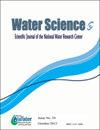Flood vulnerability and slum concentration mapping in the Indian city of Kolkata: A post-Amphan analysis
Q2 Environmental Science
引用次数: 2
Abstract
ABSTRACT The landfall of super cyclone Amphan, which affected Southern West Bengal and Orissa in 2020 and devastated human life, exposed the failure of urban infrastructure. On May 20, 2020, the storm alone recorded a rainfall of 236 mm in 24 h in Kolkata, capital city of West Bengal, pushing the total rainfall of May to 359.1 mm while averaged value of precipitation in May (2010–2019) stands at 117.5 mm. So, it further calls for relooking at climate preparedness for the Indian cities. In 2015 also, severe floods had affected more than six million people across the country of India alone, with over 250,000 people evacuated. In this context, the urban flood risks and major contributing factors in the Indian city of Kolkata have been discussed in this paper. The recurrence of floods and the exploration of causes repeatedly point to a situation of increased precipitation due to climate change, worsened by unregulated urbanization. The vulnerability assessment and calculation of Flood Vulnerability Index (FVI) for Kolkata is also conducted. It reveals the differential degree of vulnerability of city dwellers depending on location and infrastructure. The study leads to form a data base to infer characteristics and determine priority settings for the vulnerable urban population living in slums located in poorly drained areas of the city. A basin-wise analysis in KMC area reveals major urbanization coupled with decaying drainage system in the vulnerable basins as the main reason for aggravated flooding situation.印度城市加尔各答的洪水脆弱性和贫民窟集中地图:后安潘分析
超级气旋“安潘”于2020年登陆,影响了西孟加拉邦南部和奥里萨邦,摧毁了人们的生活,暴露了城市基础设施的失灵。2020年5月20日,仅西孟加拉邦首都加尔各答的24小时降雨量就达到236毫米,使5月份的总降雨量达到359.1毫米,而5月份(2010-2019年)的平均降雨量为117.5毫米。因此,它进一步呼吁重新审视印度城市的气候准备。同样在2015年,仅在印度,严重的洪水就影响了600多万人,超过25万人被疏散。在此背景下,本文讨论了印度加尔各答城市洪水风险及其主要影响因素。洪水的反复出现和对原因的探索一再表明,气候变化导致降水增加,而不受管制的城市化加剧了这一局面。对加尔各答市进行了洪水易损性评价和洪水易损性指数(FVI)计算。它揭示了城市居民因地理位置和基础设施的不同而面临的不同程度的脆弱性。该研究将形成一个数据库,用于推断居住在城市排水不良地区贫民窟的弱势城市人口的特征并确定优先设置。对KMC地区的流域分析表明,主要的城市化和脆弱流域的排水系统衰退是导致洪水情况恶化的主要原因。
本文章由计算机程序翻译,如有差异,请以英文原文为准。
求助全文
约1分钟内获得全文
求助全文

 求助内容:
求助内容: 应助结果提醒方式:
应助结果提醒方式:


